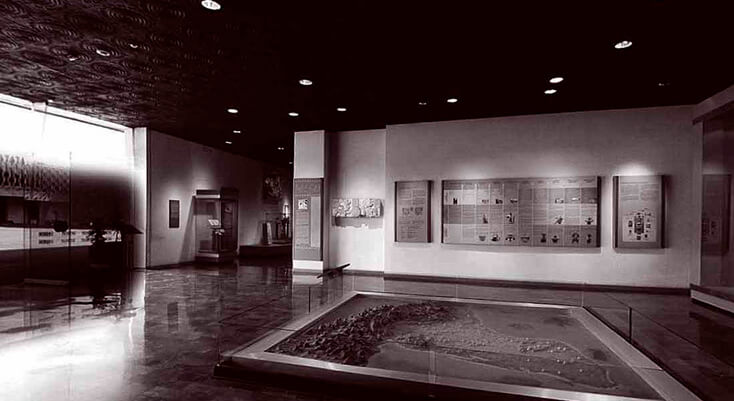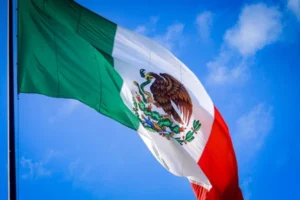Country of museum tradition
Mexico’s museum tradition has deep aspects in its history. A country with a melting pot of cultures that flourished before the arrival of the Spaniards, will demonstrate in some way the need to preserve everything that sustains its existence and historical memory. The Nahuas was a civilization that showed interest in those ethnic groups that preceded them and for that reason they were interested in every piece that they rescued from excavations to be restored and reused with attributes of their culture which is a domestic form of preservation.
In 1775 the formal beginning of the museum activity can be recorded when the Royal and Pontifical University of Mexico receives by order of the viceroy Bucareli, the documents of the collection of Lorenzo Boturini. In later years he also received the sculpture of Coatlicue found in 1790 and the Stone of the Sun. At the beginning of the nineteenth century the country received the visit of characters who managed to encourage the taste for the study of Natural Sciences and Pre-Hispanic Historical Monuments. In 1825 by presidential decree the Mexican National Museum was created operating within the spaces of the university. Later by 1865 he moved to a building on Calle de la Moneda and formally created the Museum a year later with the exhibition of pieces of archaeology and history.
Its growth merits the move to the Poplar building. In 1910 it was re-inaugurated with the collections of anthropology and history, but by 1940 the historical collection leaves and is taken to the Castle of Chapultepec leaving in exhibition only the Mexican archaeological and anthropological heritage. Over the years the construction project of the definitive headquarters in the Chapultepec Forest was created, starting its construction in 1963 with the design of the architect Pedro Ramírez Vásquez with the collaboration of his colleagues Rafael Mijares and Jorge Campuzano. The National Museum of Anthropology of Mexico was inaugurated on September 17, 1964 by then-President Adolfo López Mateos.
Importance of the National Museum of Anthropology
Among its functions, the National Museum of Anthropology aims to promote and disseminate ancient and current Mesoamerican cultures for national and international recognition and appreciation, through the exhibition of tangible and intangible pieces, objects and creations that are part of the Mexican ethnographic and archaeological heritage. Likewise, to promote activities to disseminate anthropology in Mexico through workshops, conferences, guided tours; likewise, the conservation, registration and restoration of Mexican ethnographic and archaeological heritage; as well as the processes of research, dissemination and publication of studies that enrich the Mexica cultural heritage, also known as Azteca.
Architecture
The National Museum of Anthropology was located in the Palacio de la Moneda in the Historic Center, until the need to move its spaces to house exclusively the archaeological and ethnographic archive of the country was raised, so a construction project was established on land in the Chapultepec Forest. Through a presidential speech, its inauguration was held on September 17, 1964 as a great act of transcendence for the country where “… today’s Mexico pays homage to indigenous Mexico in whose example it recognizes characteristics of its national originality.”, in the words of the then President of the Republic Adolfo López Mateos.
It was not planned as a simple depository of the heritage assets of Mexico, but also its structure forms a heritage asset in itself, for its architectural aesthetic proposal and for the functionality of its spaces for which it was designed. The total area occupied by the museum is 79,700 square meters with a construction area of 45,000 square meters. Of these, 30,000 occupy the exhibition and exhibition halls, the rest is destined to various services such as library, restoration workshops, conservation, academic area, warehouses.
The architectural style of the building seeks to connect and integrate into the environment as it is integrated into Mayan architecture. A feature to highlight are the differentiated heights of the ceilings of each of the rooms to highlight the monumentality of some of the pieces exhibited. It has 23 rooms, uncovered areas such as the central courtyard, the access square and other surrounding spaces with some subsidence.
There is a lily pond that is located in the courtyard in front of the Mexica room recalling its lake or aquatic origin that characterizes this culture. The room and the water mirror are joined by a white marble platform at the junction of which ends with a symbology of the four elements: earth, water, air and fire. There is a lattice that is a sculptural piece by the master Manuel Felguerez, where a snake of geometric appearance and anodized aluminum located on the upper floor of the interior of the patio is evoked. The entrance of the Museum by The Paseo de la Reforma is sheltered and welcomes the monolith of the God Tlaloc. Its construction involves two systems, steel and concrete and highlights the umbrella as a huge suspended roof as a center or focus of interest of the courtyard, recalling its open shape to the Mayan ceremonial centers.
Touring the Museum
On the tour of the Museum we will find thousands of archaeological pieces on display that are testimony to the existing cultures, before the arrival of the Spaniards as well as those that endure today. You’ll need time to tour more than its 20 showrooms. The tour begins on the ground floor where pieces from the Mesoamerican Mayan and Mexica cultures welcome you. 8,000 pieces such as Olmec heads carved in stones, the Mayan room with its exhibition of tombstones and replica of temples with painted murals.
The iconographic piece of the Museum and the most celebrated is the Aztec calendar, “La Piedra del Sol”, a stone monolith discovered in the year 1700 in excavations carried out under an important square in Mexico, measures 4 meters wide and weighs 24 tons. The engravings he presents show great artistic expertise. You will also find a few steps away statues of Aztec goddesses and the model representation of the ancient city of Tenochtitlan today Mexico City. The adjoining floor is dedicated to the current indigenous populations descendants of the ancient settlers where pieces of daily use, belongings, fabrics, religious objects and their system of life are exhibited. The museum also has three auditoriums and the National Library of Anthropology and History.
Exhibition Halls
The National Museum of Anthropology has 22 permanent exhibition rooms spread over the two levels of the museum and 2 traveling exhibition rooms where samples of pieces from international museums are exhibited. On the ground floor are distributed the rooms of anthropology and pre-Columbian cultures of Mexico. On the first floor there are 11 ethnographic exhibition rooms where current indigenous cultures are exhibited. Ethnographic exhibition rooms are achieved around the central courtyard where the pond is located.
- Room 1, Introduction to Anthropology, which shows the development and sociocultural evolution of the human being, diversity and adaptation to the environment.
- Room 2, Poblamiento de América, presents the evolution of the settlers who arrived in America.
- Room 3, Preclassic in the Central Highlands, exhibits pieces made between THE XXIII a.c. and I d.c.
- Room 4, Teotihuacan Room, dedicated to one of the most important archaeological sites in Latin America.
- Room 5, The Toltecs and the Epiclassic, presents as a central theme the Toltec culture.
- Room 6, Mexico, shows the importance and power of this culture in the mid-fourteenth century.
- Room 7, Cultures of Oaxacas, shows the cultural complexity of Monte Albán.
- Room 8, Cultures of the Coast of Mexico, Olmec culture, El Tajín and Huasteca.
- Room 9, Maya, exhibition of this Mesoamerican culture that covers part of Mexico and Central America.
- Room 10, West, cultures of western Mesoamerica.
- Room 11, North, covering the northern states of Mexico.
- Room 12, Pueblos Indios, shows the current indigenous populations of Mexico.
- Room 13, Great Nayar, culture of the Nayars.
- Room 14, Puréecherio, shows the worldview of the current ethnic group of the Purépechas.
- Room 15, Otopame, current cultures of the Ottoman peoples and the Otomi-Mazahuas.
- Room 16, Sierra de Puebla, exhibits the Totonac, Otomies, Tepehuas and Nahuas culture.
- Room 17, Oaxaca, Pueblos Indios del Sur.
- Room 18, Gulf Coast: Huastecas and Totonacapán.
- Room 19, Mayan Villages of the Plain and the Jungles.
- Room 20, Mayan Villages of the Mountain.
- Room 21, The Northwest, mountains, deserts and valleys.
- Room 22, Los Nahuas, the broadest ethnic group in present-day Mexico.
As for the permanent exhibitions we have the exhibition in the garden of the Toltec Room the Mesoamerican Ball Game. It also contemplates the existence of two itinerant rooms where collections of international museums are exhibited.
Conservation
In principle this area, which was a workshop, was converted into a laboratory to intervene in an integral way all the pieces or objects of the collections of archaeology, ethnography, historical archive, modern and contemporary work, and artistic architectural elements, through conservation and restoration of the heritage assets that are under the protection of the museum. It also formulates research and conservation plans and projects that systematicize and direct the processes. In short, this area’s mission is to be at the forefront of the processes that guarantee the good attention of heritage and cultural assets hand in hand and in agreement with the most prestigious institutions and universities in the country.
In the museum we can find paintings and murals by Mexican artists of the twentieth century such as Rufino Tamayo, Luis Covarrubias, Jorge González Camarera, Rául Angiano and Eleonora Carrington. It also has a shop, restaurant, bookstore, courses, workshops, program of guided tours, artistic events, academic events, video libraries and audio guides. The Anthropology and History Book Fair is held in the spaces of its central courtyard.
With the inauguration of the National Museum of Anthropology of Mexico, the aspirational feeling of the Mexican people to have a space that honors and dignifies the great legacy of the different Amerindian cultures that forged the identity and the local idiosyncrasy was addressed. Its consolidation and specialization in each of the museum work of research, compilation, preservation, restoration and exhibition that it carries out, have made it a world reference for the patrimonial and archaeological wealth that it protects. That is why it becomes a mandatory destination if you plan to travel to Mexico in order to swell the list of more than two million annual visitors it receives.










